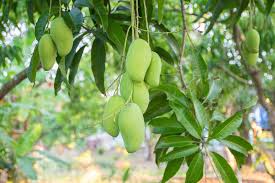
Disease management of mangoes
Share
Introduction
There are many mango varieties, but common diseases affect most. Here's a look at some prevalent diseases and their control methods:

Anthracnose
Mango anthracnose disease
This fungal disease causes sunken spots and black, scabby patches on leaves, fruits, and stems.
Control: Prune infected parts, apply copper-based fungicides like Bordeaux mixture or copper oxychloride before flowering and after harvest.

Powdery Mildew
Mango powdery mildew disease
This fungal disease forms white powdery patches on leaves, flowers, and young fruits, stunting growth.

Control: Use sulfur-based fungicides during the dry season, ensuring good air circulation around trees.
Dieback
Mango dieback disease
This fungal disease causes twigs and branches to die back, with black lesions and cankers.

Control: Prune infected branches, apply copper-based fungicides or carbendazim fungicides.

Bacterial Canker
Mango bacterial canker disease
This bacterial disease causes dark, water-soaked spots on leaves, stems, and fruits that turn black and ooze bacterial ooze.

Control: Prune infected parts, apply streptomycin or oxytetracycline antibiotics during the rainy season.
Sooty Mold
Mango sooty mold disease
This black, sooty mold isn't a direct pathogen but grows on the honeydew secretions of sap-sucking insects like aphids and scales.

Control: Manage the primary insect infestation to prevent mold growth. Apply insecticidal soap or neem oil.

General Disease Management Practices
Preventive measures are crucial. Choose disease-resistant varieties, provide proper drainage, avoid overhead watering, and maintain good orchard hygiene by removing fallen leaves and debris.Monitor your trees regularly for signs of disease. Early detection and treatment are essential.
Organic options like neem oil, potassium bicarbonate, and Bordeaux mixture can be used for disease control, following recommended application rates.
Chemical fungicides should be a last resort and used judiciously following label instructions to avoid resistance buildup and environmental harm.
Mango Varieties
There are huof mango varieties worldwide, each with unique characteristics. Here are some of the most common:
Indian varieties like Alphonso, Kesar, Dasheri, Langra, and Neelam are known for their swVand intense flavor.Southeast Asian varieties like Carabao (Phillipines), Nam Dok Mai (Thailand), and Kluay Sab-A (Thailand) are known for their vibrant colors, thin skin, and fiberless flesh.
Florida varieties like Tommy Atkins, Haden, and Kent are popular for their adaptability, disease resistance, and good eating qualities.
Advanced Disease Management Techniques
Cultural Practices:
Sanitation: Regularly remove fallen leaves, fruits, and debris around the tree to reduce disease inoculum (spores and bacteria) buildup.Pruning: Prune diseased branches well below the infected area and properly dispose of them. Prune during dry weather to minimize disease spread.
Irrigation Management: Avoid overhead watering, which can promote fungal diseases. Opt for drip irrigation to deliver water directly to the roots.
Nutrient Management: Ensure proper fertilization to maintain tree health and resistance to diseases.
Biological Control:
Introduce beneficial insects like ladybugs or lacewings to control insect pests that contribute to sooty mold growth.Apply biofungicides containing beneficial bacteria or fungi that can suppress disease-causing pathogens.
Fungicide Selection and Application:
Fungicide resistance is a growing concern. Rotate fungicides with different modes of action to prevent resistance development.Proper application is crucial. Follow label instructions for mixing rates, timing, and spray coverage.
Integrated Pest Management (IPM): Combine various control methods for a holistic approach. This reduces reliance on chemicals and promotes a healthier orchard ecosystem.
Post-Harvest Disease Management
Careful harvesting: Avoid damaging fruits during harvest, as wounds create entry points for pathogens.
Proper handling: Handle fruits gently to minimize bruising and scratching.
Waxing: Apply a thin coat of food-grade wax to some varieties to create a barrier against moisture loss and disease pathogens.
Storage: Maintain proper storage conditions (temperature, humidity) to slow down fruit ripening and disease development.
Conclusion
Effective disease management is crucial for maintaining the health and productivity of mango orchards. By implementing integrated pest management practices, timely application of fungicides, and ensuring proper orchard hygiene, growers can minimize the impact of diseases such as anthracnose and powdery mildew. Regular monitoring and early detection are key to preventing outbreaks and ensuring a bountiful harvest of high-quality mangoes. With careful attention to these practices, mango farmers can safeguard their crops and sustainably manage disease pressures for years to come."
